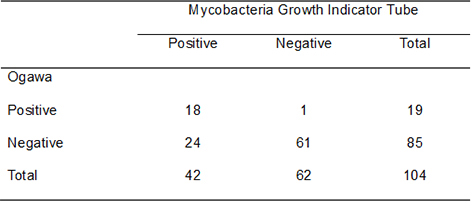1. Cruciani M, Scarparo C, Malena M, Bosco O, Serpelloni G, Mengoli C. Meta-analysis of BACTEC MGIT 960 and BACTEC 460 TB, with or without solid media, for detection of mycobacteria. J Clin Microbiol. 2004; 42:2321–2325.
2. Dinnes J, Deeks J, Kunst H, Gibson A, Cummins E, Waugh N, Drobniewski F, Lalvani A. A systematic review of rapid diagnostic tests for the detection of tuberculosis infection. Health Technol Assess. 2007; 11:1–196.
3. Anthony RM, Cobelens FG, Gebhard A, Klatser PR, Lumb R, Rüsch-Gerdes S, van Soolingen D. Liquid culture for Mycobacterium tuberculosis: proceed, but with caution. Int J Tuberc Lung Dis. 2009; 13:1051–1053.
4. Tenover FC, Crawford JT, Huebner RE, Geiter LJ, Horsburgh CR Jr, Good RC. The resurgence of tuberculosis: is your laboratory ready? J Clin Microbiol. 1993; 31:767–770.
5. Canadian Thoracic Society. Canadian Tuberculosis Standards, 7th Edition. Can Respir J. 2013; 20:1A–173A.
6. Gopi A, Madhavan SM, Sharma SK, Sahn SA. Diagnosis and treatment of tuberculous pleural effusion in 2006. Chest. 2007; 131:880–889.
7. Maartens G, Bateman ED. Tuberculous pleural effusions: increased culture yield with bedside inoculation of pleural fluid and poor diagnostic value of adenosine deaminase. Thorax. 1991; 46:96–99.
8. Cheng AF, Tai VH, Li MS, Chan CH, Wong CF, Yew WW, Hui M, Chan CY, Lee JC. Improved recovery of Mycobacterium tuberculosis from pleural aspirates: bedside inoculation, heparinized containers and liquid culture media. Scand J Infect Dis. 1999; 31:485–487.
9. Luzze H, Elliott AM, Joloba ML, Odida M, Oweka-Onyee J, Nakiyingi J, Quigley M, Hirsch C, Mugerwa RD, Okwera A, et al. Evaluation of suspected tuberculous pleurisy: clinical and diagnostic findings in HIV-1-positive and HIV-negative adults in Uganda. Int J Tuberc Lung Dis. 2001; 5:746–753.
10. Ruan SY, Chuang YC, Wang JY, Lin JW, Chien JY, Huang CT, Kuo YW, Lee LN, Yu CJ. Revisiting tuberculous pleurisy: pleural fluid characteristics and diagnostic yield of mycobacterial culture in an endemic area. Thorax. 2012; 67:822–827.
11. von Groote-Bidlingmaier F, Koegelenberg CF, Bolliger CT, Chung PK, Rautenbach C, Wasserman E, Bernasconi M, Friedrich SO, Diacon AH. The yield of different pleural fluid volumes for Mycobacterium tuberculosis culture. Thorax. 2013; 68:290–291.
12. Kwon JS, Cha SI, Jeon KN, Kim YJ, Kim EJ, Kim CH, Park JY, Jung TH. Factors influencing residual pleural opacity in tuberculous pleural effusion. J Korean Med Sci. 2008; 23:616–620.
13. Liu SF, Liu JW, Lin MC. Characteristics of patients suffering from tuberculous pleuritis with pleural effusion culture positive and negative for Mycobacterium tuberculosis, and risk factors for fatality. Int J Tuberc Lung Dis. 2005; 9:111–115.
14. Bielsa S, Palma R, Pardina M, Esquerda A, Light RW, Porcel JM. Comparison of polymorphonuclear- and lymphocyte-rich tuberculous pleural effusions. Int J Tuberc Lung Dis. 2013; 17:85–89.
15. Antony VB, Sahn SA, Antony AC, Repine JE. Bacillus Calmette-Guérin-stimulated neutrophils release chemotaxins for monocytes in rabbit pleural spaces and in vitro. J Clin Invest. 1985; 76:1514–1521.
16. Jolobe OM. Atypical tuberculous pleural effusions. Eur J Intern Med. 2011; 22:456–459.
17. Lin MT, Wang JY, Yu CJ, Lee LN, Yang PC. TAMI Group. Mycobacterium tuberculosis and polymorphonuclear pleural effusion: incidence and clinical pointers. Respir Med. 2009; 103:820–826.
18. Korea Centers for Disease Control and Prevention. Annual report on the notified HIV/AIDS in Korea, 2013. Seoul: Korea Center for Disease Control & Prevention;2014.








 PDF
PDF ePub
ePub Citation
Citation Print
Print




 XML Download
XML Download